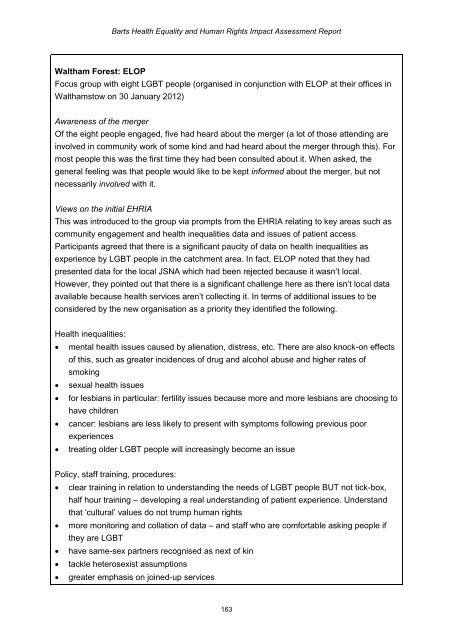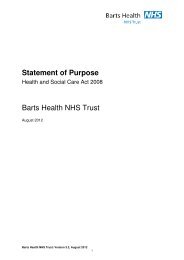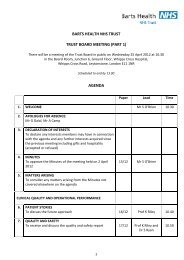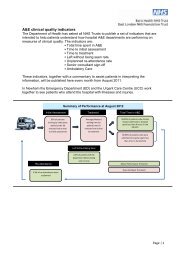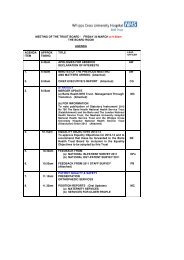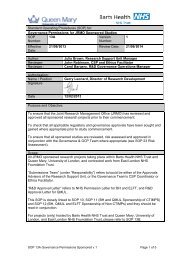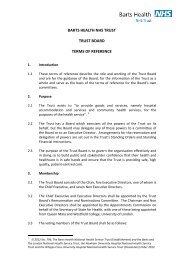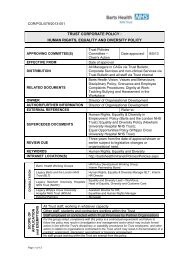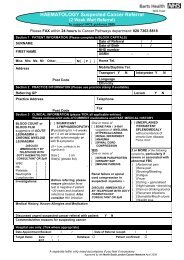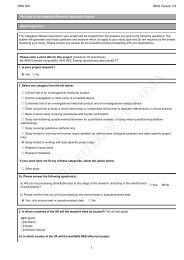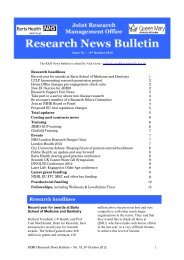Barts Health Equality and Human Rights Impact Assessment Report
Barts Health Equality and Human Rights Impact Assessment Report
Barts Health Equality and Human Rights Impact Assessment Report
- No tags were found...
You also want an ePaper? Increase the reach of your titles
YUMPU automatically turns print PDFs into web optimized ePapers that Google loves.
<strong>Barts</strong> <strong>Health</strong> <strong>Equality</strong> <strong>and</strong> <strong>Human</strong> <strong>Rights</strong> <strong>Impact</strong> <strong>Assessment</strong> <strong>Report</strong>Waltham Forest: ELOPFocus group with eight LGBT people (organised in conjunction with ELOP at their offices inWalthamstow on 30 January 2012)Awareness of the mergerOf the eight people engaged, five had heard about the merger (a lot of those attending areinvolved in community work of some kind <strong>and</strong> had heard about the merger through this). Formost people this was the first time they had been consulted about it. When asked, thegeneral feeling was that people would like to be kept informed about the merger, but notnecessarily involved with it.Views on the initial EHRIAThis was introduced to the group via prompts from the EHRIA relating to key areas such ascommunity engagement <strong>and</strong> health inequalities data <strong>and</strong> issues of patient access.Participants agreed that there is a significant paucity of data on health inequalities asexperience by LGBT people in the catchment area. In fact, ELOP noted that they hadpresented data for the local JSNA which had been rejected because it wasn’t local.However, they pointed out that there is a significant challenge here as there isn’t local dataavailable because health services aren’t collecting it. In terms of additional issues to beconsidered by the new organisation as a priority they identified the following.<strong>Health</strong> inequalities: mental health issues caused by alienation, distress, etc. There are also knock-on effectsof this, such as greater incidences of drug <strong>and</strong> alcohol abuse <strong>and</strong> higher rates ofsmoking sexual health issues for lesbians in particular: fertility issues because more <strong>and</strong> more lesbians are choosing tohave children cancer: lesbians are less likely to present with symptoms following previous poorexperiences treating older LGBT people will increasingly become an issuePolicy, staff training, procedures: clear training in relation to underst<strong>and</strong>ing the needs of LGBT people BUT not tick-box,half hour training – developing a real underst<strong>and</strong>ing of patient experience. Underst<strong>and</strong>that ‘cultural’ values do not trump human rights more monitoring <strong>and</strong> collation of data – <strong>and</strong> staff who are comfortable asking people ifthey are LGBT have same-sex partners recognised as next of kin tackle heterosexist assumptions greater emphasis on joined-up services163


